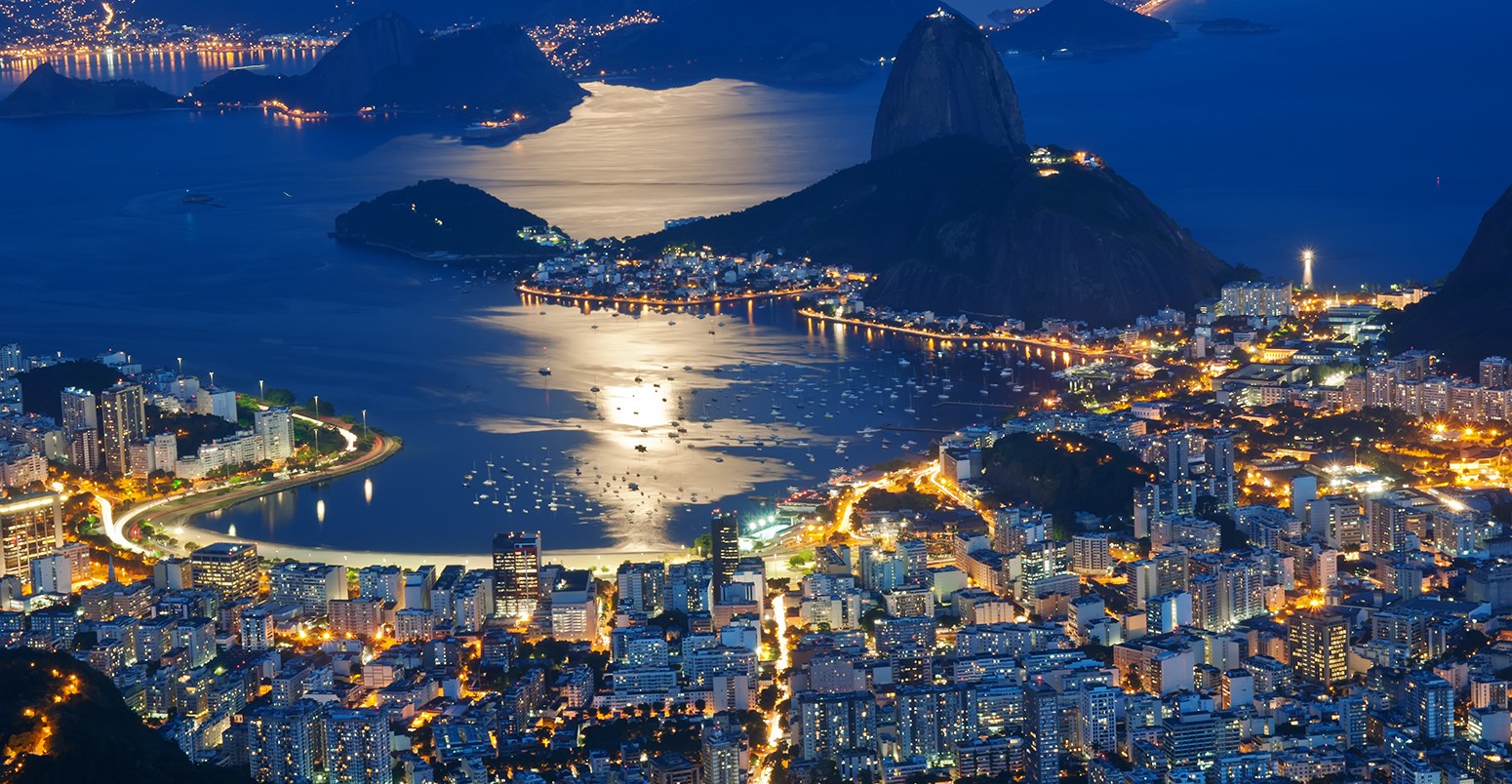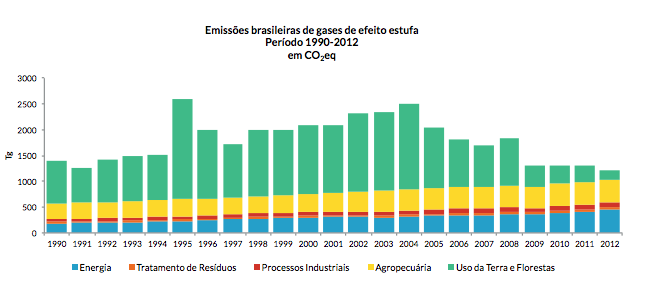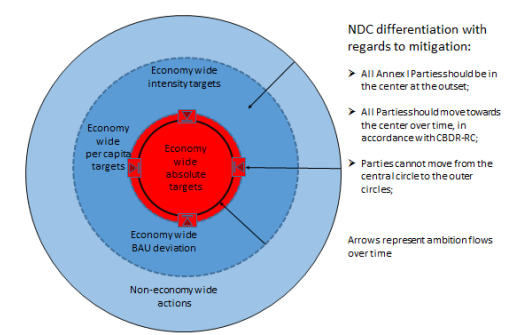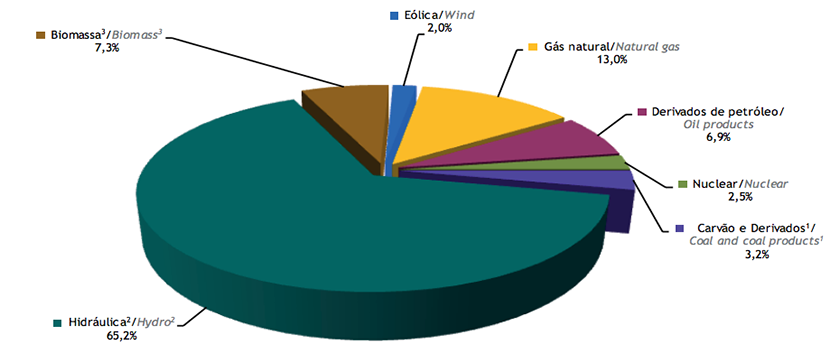Analysis: Brazil’s climate pledge represents slight increase on current emissions
Sophie Yeo
09.29.15Sophie Yeo
29.09.2015 | 3:15pmBrazil has pledged to reduce its greenhouse gas emissions to 37% below 2005 levels by 2025.
The pledge, which constitutes its formal submission to the UN’s forthcoming climate deal, also includes an “indicative contribution” of a 43% reduction in emissions by 2030.
Announcing the target at the UN General Assembly in New York on the weekend, Brazilian president Dilma Rousseff said that the country’s goals were “just as ambitious, if not more so, than those set by developed countries”.
This makes Brazil the first major developing economy to set an absolute economy-wide emissions target. The pledge was warmly received by campaigners and the media, with Reuters reporting that Brazil had pledged to “slash emissions”.
Nonetheless, the pledge itself represents a slight increase on Brazil’s current emissions, illustrating the shifting balance between land use and the energy sector as the primary source of the country’s emissions.
Rising emissions
Brazil is the world’s twelfth largest emitter of CO2. Its emissions shrunk by 41% between 2005 and 2012, thanks to its success in reducing emissions from deforestation.
Source: Annual estimates of greenhouse gases emissions in Brazil, Ministry of Science, Technology and Innovation, Brazil
According to forest monitoring data collected by the federal government in Brazil, deforestation fell by an average of 16% per year between 2005 and 2014 (green bars, above). This has been mostly thanks to policies designed to reduce deforestation.
At the same time, emissions from the energy and agriculture sectors have continued to rise, taking up a considerably larger share of Brazil’s overall emissions.
Brazil’s emissions, which peaked in 2004, will, therefore, peak again before they start to decline. This is partly because the country’s efforts to reduce emissions are taking place in a context of rising population, GDP and income per capita.
Each of these puts an upward pressure on emissions, as there are more people with the means to use more energy.
But it also takes place in the context of an increasing deforestation rate, after years of decline. The rate of deforestation in the Amazon increased by 28% between August 2012 and July 2013. Environmentalists have blamed the reversal on the reform of the forest protection law in 2012.
As a result, Brazil’s pledge to reduce emissions by 37% by 2025 leaves room for the country to increase its emissions over the next decade. The INDC points out that, in 2012, emissions were 41% below 2005 levels.
In absolute terms, this means that emissions in Brazil will reach 1.3bn tonnes of CO2 equivalent (GtCO2e) by 2025, compared to 1.2GtCO2e in 2012.
Brazil’s indicative target of a 43% reduction below 2005 levels in 2030 will mean its emissions are once again brought down to 1.2GtCO2e. This implies its emissions will peak for a second time some time between 2025 and 2030.
Other measures
While Brazil has chosen to express its target as an economy-wide reduction, this is not the only way to frame a carbon-cutting goal.
In fact, when it comes to developing countries, this is an unusual approach. Most other developing countries have so far expressed their targets in terms of how far they will deviate from a business-as-usual trajectory. Tunisia and Singapore have talked about reducing their carbon intensity, as has China, which has also set a peak year for emissions.
While developed countries are expected to put forward an economy-wide target, this is not necessarily expected of developing economies, which have historically emitted less, and want to be given leeway to continue to emit as they continue on their development pathway.
In additional information provided alongside its INDC, Brazil outlines how its target looks when framed by these other measures.
In terms of emissions intensity (the volume of greenhouse gases emitted per unit of GDP), Brazil’s 37% reduction target represents a 66% reduction by 2025 and 75% reduction by 2030, both compared to a 2005 baseline.
Thanks to the projected rise in population, the target also represents an absolute reduction in emissions per capita. This is expected to shrink to 6.2tCO2e in 2025 and 5.4tCO2e in 2030, compared to 6.5tCO2e in 2012. In 2012, each citizen of the EU was emitting an average of 9tCO2e.
Politics
The fact that Brazil has chosen to express its target as an absolute reduction could be a sign of political ambition as the UN climate talks this December loom ever closer.
Carlos Rittl, head of the Brazil-based organisation Observatório do Clima, tells Carbon Brief:
“Brazil is well positioned in the international negotiations by announcing its INDC. I think it allows them to ask others to do more. By putting themselves in this economy-wide target, Brazil is saying, ‘Look, we’re doing more, we are differentiating ourselves from even the developing nations by the nature of our target’.”
Brazil’s decision to frame its INDC as a 2025 goal with a further 2030 indicative target is in line with its position at the UN talks to have five-year cycles of ambition accompanied by a less formal ten-year target.
Its economy-wide target also aligns with Brazil’s unique proposal for commitments that gradually increase based on the level of development. They have coined the phrase“concentric differentiation” to describe this, and it has been seen as a potential method for getting around the binary division between developed ( Annex I) and developing ( Non-Annex I) countries that has been a source of conflict at UN negotiations.
Brazil’s proposal for “concentric differentiation”. Source: Brazilian submission to the UNFCCC
These features of its INDC suggests that Brazil is gearing up to play a key diplomatic role in the UN climate negotiations this December.
Deforestation
But, Rittl adds, “we are still not there yet”. Non-governmental organisations, including Observatório do Clima and the World Resources Institute, have called for a stronger commitment from Brazil, and, in particular, have expressed disappointment at the deforestation element of the pledge.
Brazil has pledged in its INDC to end illegal deforestation in the Brazilian Amazon by 2030 and to restore and reforest 12m hectares of forests by 2030, reiterating the joint pledge that Rousseff made with President Barack Obama at the White House in June.
But this is a step backwards from Brazil’s proposal in 2008 to achieve zero net deforestation by 2015. Brazil is far from achieving this pledge, and has not recommitted to it in its INDC. Rittl tells Carbon Brief:
“Considering that Brazil aims to halt illegal deforestation only in the Amazon and only by 2030 is absolutely weak. It means that we would be living with environmental crimes in the Amazon for at least an additional 15 years and in the other regions of Brazil by 2030 we will be still dealing with illegal deforestation Considering the size of its economy, it’s just not acceptable to have that for 15 more years.”
Renewables
Brazil has also used its INDC to spell out what its energy and electricity mixes will look like by 2030.
Currently, Brazil gets around 75% of its electricity from renewables – made up of the hydro, biomass and wind segments of the pie chart below.
Brazil’s domestic electricity supply in 2014. Source: Brazilian Energy Balance 2015, Energy Research Agency
Brazil’s energy mix consists of 40% renewables – the hydro, firewood and charcoal, sugar cane products and other renewables segments of the pie chart below.
Brazil’s domestic energy supply in 2014. Source: Brazilian Energy Balance 2015, Energy Research Agency
Brazil intends to shift its energy mix further towards renewables by 2030, according to its INDC.
Renewables will make up a 45% share of its energy mix by 2030, with renewable sources, excluding hydropower, to occupy between 28% and 33% of the total.
Meanwhile, renewables will constitute at least a 23% share in Brazil’s power mix by 2030, also excluding hydropower. This will be achieved by raising the share of wind, biomass and solar, and achieving efficiency gains of at least 10%, the INDC promises.
Conclusion
Brazil has gone above and beyond other large developing countries by promising an absolute economy-wide target.
While this doesn’t equate to a reduction on current emission levels, and has disappointed NGOs with regard to its commitment on deforestation, the fact that Brazil is choosing to frame its target in the same way as other major players, such as the US and the EU, is being viewed as an important statement about its seriousness on tackling climate change.
The INDC hints at Brazil’s political ambitions when it comes to negotiating the UN climate deal in Paris this December.
Main image: Night view of Sugar Loaf mountain and Botafogo in Rio de Janeiro. Credit: Catarina Belova/Shutterstock.com.
-
Brazil has pledged to reduce its greenhouse gas emissions to 37% below 2005 levels by 2025 in its #INDC
-
President Dilma Rousseff on Brazil's #INDC goals: "just as ambitious, if not more so, than those set by developed countries"






